Korean BBQ is the Perfect Chill Holiday Dinner. · i am a food blog
A Korean BBQ at home is the best kind of dinner party and the best holiday dinner by far.
It’s easy, it’s quick, and it’s fun. This is a little 101 on all things Korean BBQ at home. What it is, what you should buy, how you should set the table, and how you do it.
Why you should throw yourself a Korean BBQ party
Korean barbecue is all about balance and contrast between flavors and textures. It’s completely customizable so that everyone at the table can eat exactly what they want.
Here’s what happens when you go out for KBBQ: You sit down and a bunch of tiny plates that you haven’t ordered come out. These are banchan: little side dishes that go with Korean BBQ. You order your meats and they come to the table, raw. You grill them, wrap them up in lettuce, dip/top them, then eat them up. Everything is smoky, meaty, savory, and delicious. Eat meat, drink copious amounts of alcohol, and repeat!


Sounds fun right?! Mike and I LOVE going for Korean barbecue. It’s one of our things – late night grilling and chatting the night away. I like the interactive part of it and Mike likes the meat and alcohol. We both love the food. We’ve eaten at countless Korean barbecue restaurants and earlier this year, when everyone was in lockdown, we were really, really missing Korean barbecue. It was an itch we just had to scratch. So we did the thing: the ultimate way to KBBQ, right at home.
Table of Contents
What is Korean BBQ
Korean BBQ is the popular method of grilling meat right at the dining table. Korean BBQ restaurants have gas, charcoal, or portable stove grills built into the tables. Marinated meats like bulgogi and kalbi are grilled and eaten along with various small Korean side dishes called banchan.
This is a really long post, but the gist of it is: grill meat at the table, pop it into a leafy vegetable, top it off with sauce and enjoy.
At the very minimum you’ll need:
- A grill/hot plate.
- Marinated meats.
- Vegetables + sauce.
- Banchan or side dishes. This is optional, I guess, but it’s not really Korean BBQ with out it.
- Drinks. A key part of KBBQ.
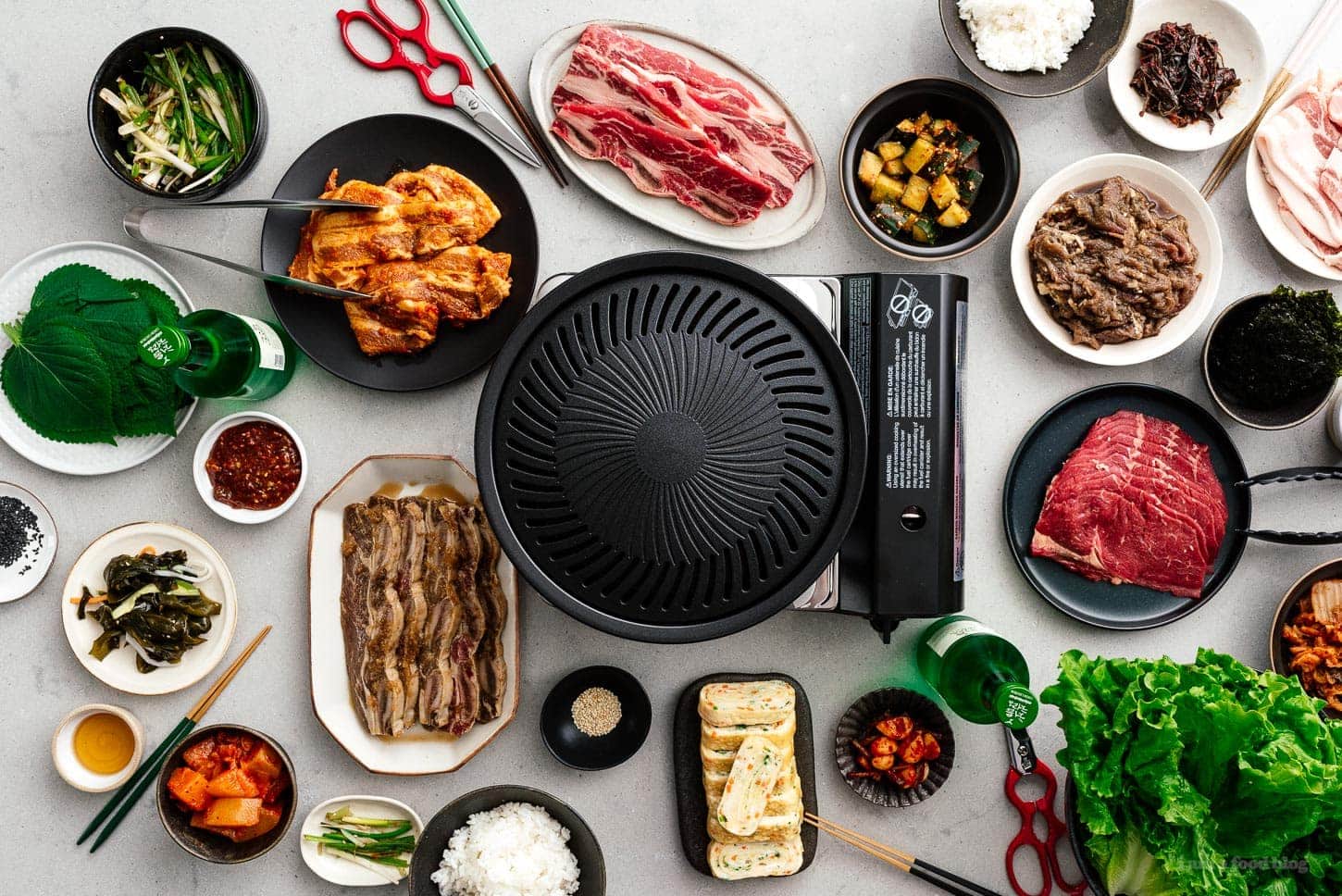

How to make Korean BBQ
- A few hours before you want to eat, or the day before, marinate the meats, prep the vegetables, buy the banchan, and make the sauces in this post. Buy the liquor you need and refrigerate because no one should drink warm soju if they can avoid it.
- When you are ready to eat, make the rice and the noodles and set the table up with banchan, dipping sauces, rice, and noodles.
- Heat up your grill or hot plate. Make sure the windows are open if you’re inside.
- Brush some oil on the grill.
- When it’s hot, add some slices of meat. Flip as needed.
- As the pieces are cooked, take them off the grill, wrap it up, top it, sauce it, and eat it. See below for details. You can also take the cooked pieces off the grill and place them on a plate. Cook, eat, and repeat.
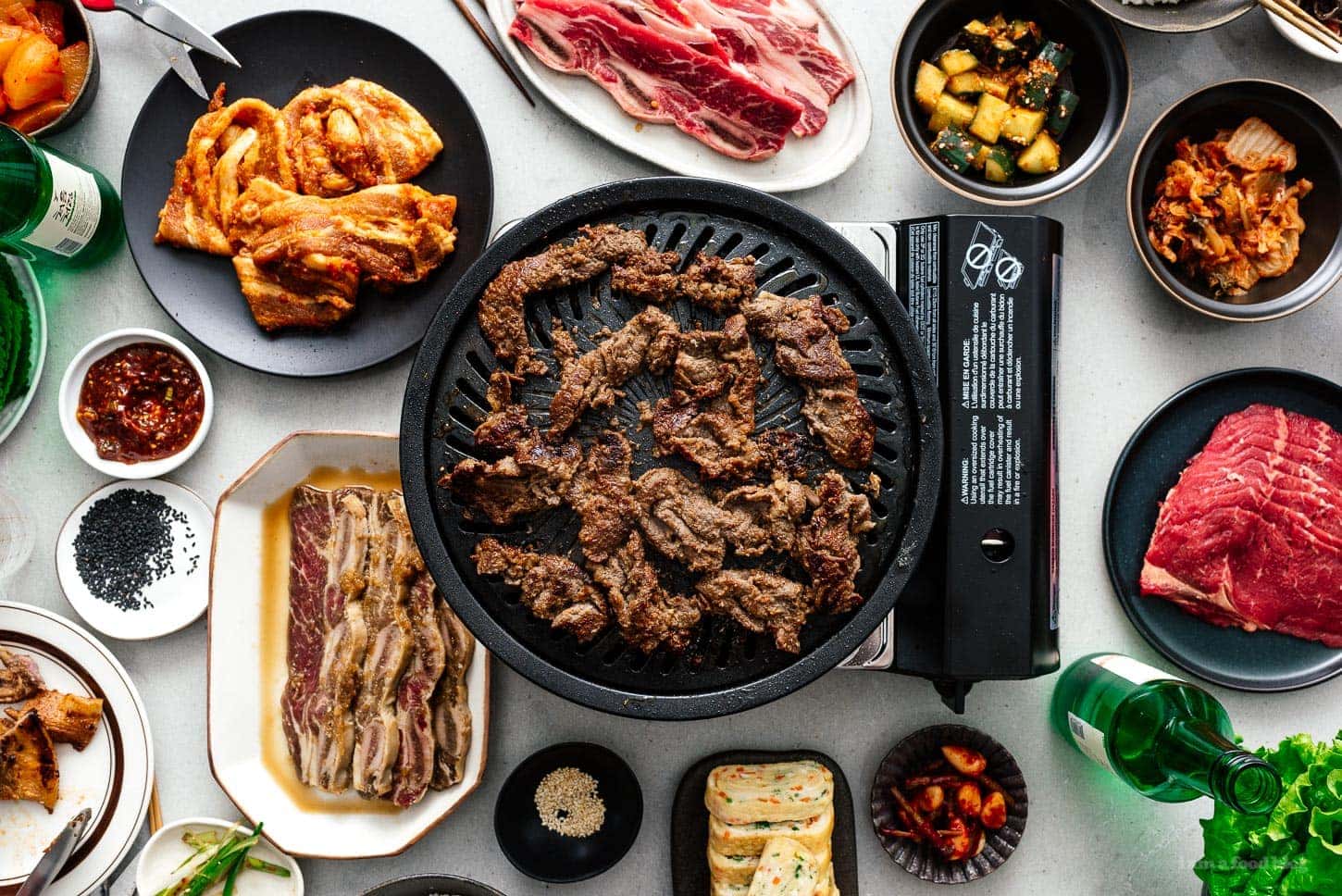

How to eat KBBQ
Korean BBQ is traditionally eaten in ssam form. Ssam just means wrap, but the implication is a one-bite-sized wrap of fresh cold lettuce with a small piece of grilled meat and topped with sauce (ssamjang).
- Grill some meat (above). If it is too large to eat as one bite (as in the case of short ribs) use a pair of kitchen shears to cut it down. This is traditional.
- Wrap it up in lettuce and perilla.
- Top or dip it in sauce.
- One bite it.
- Savor and repeat!
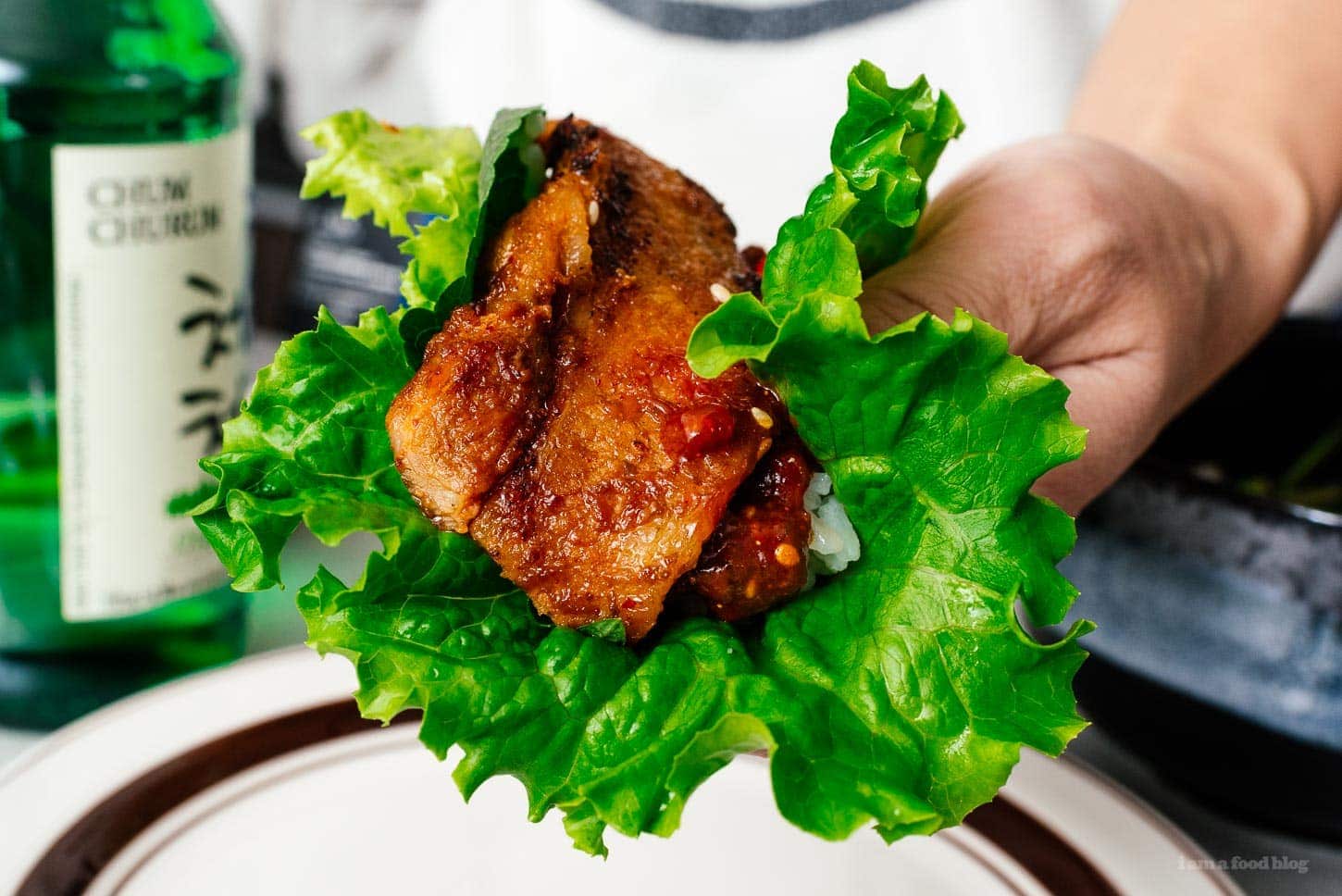

What should I buy for Korean BBQ at home
To be honest, you can probably buy everything you need at H-Mart or a local Korean grocery store. They’ll even have marinated meats for you. If you don’t live near a Korean grocery store, you can buy meat and marinate it yourself. Don’t sweat it if you don’t have any banchan. At its core, Korean barbecue is about wrapping delicious meat in lettuce and dipping it in ssamjang.
What kind of grill do you need?
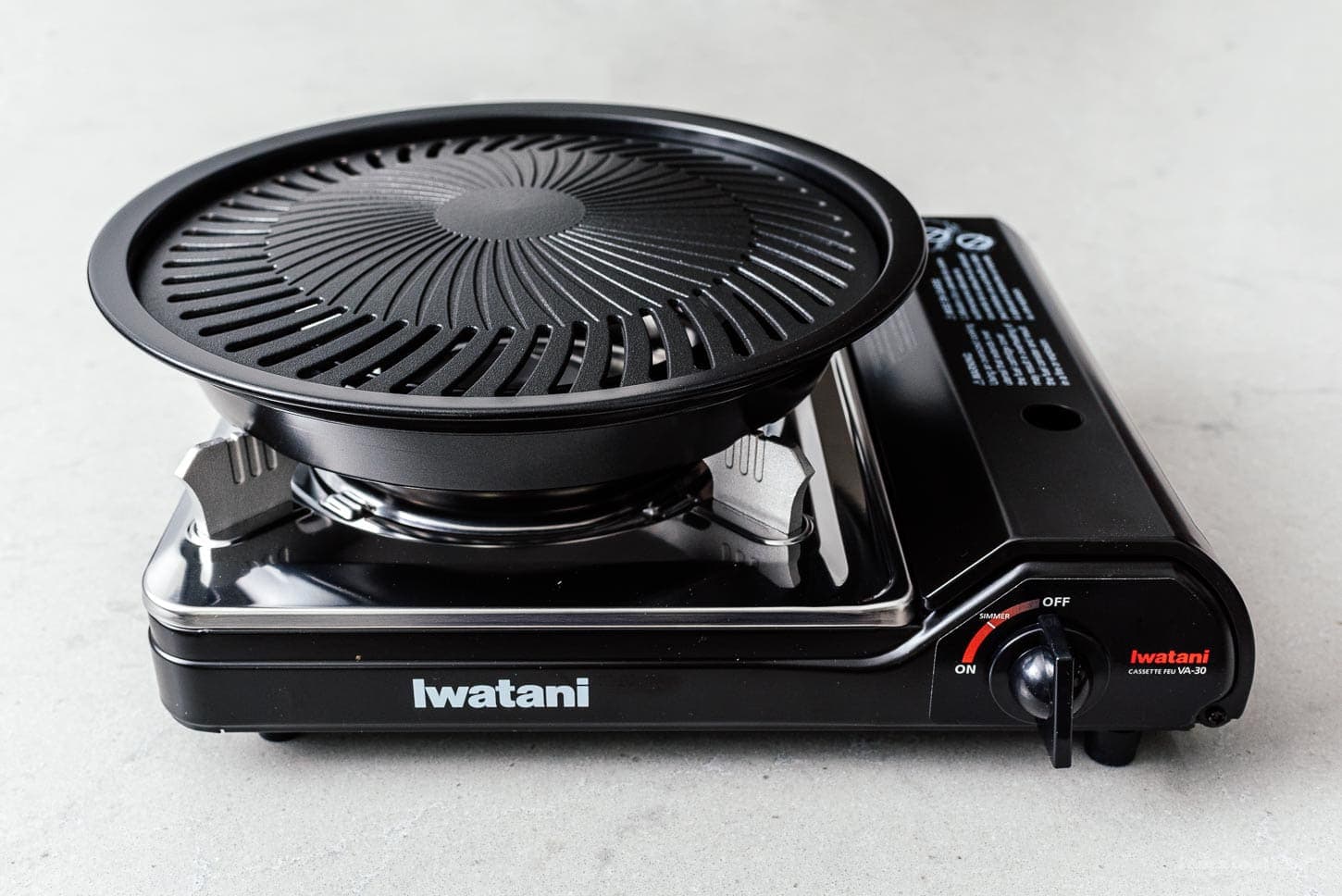

The most important thing you’ll need for Korean BBQ is a grill or hot plate. A korean BBQ grill is specifically designed to let the fat safely run off without flaring up so that you can cook indoors, and also not let any thinly sliced or tiny pieces of meat fall through. They sell a bunch of different ones online and they also sell them at Asian grocery stores. Besides the grill, you need a heat source. Your options are:
- Charcoal – best tasting but you can’t use charcoal indoors or on balconies and it’s the biggest pain to get charcoal lit, let it cool down after, and dispose of properly. If you have a backyard and want to take things to the next level, you should give it a try though!
- Induction – induction is nice because it’s safe and easy to clean, but it doesn’t get as hot as Korean BBQ should get, and you have to use induction specific metal that can be hard to find in Korean BBQ grill pan shapes. We have an induction cooktop but we don’t use it because the next option is the best.
- Portable Butane Stove – these can be used indoors (with proper ventilation) and get plenty hot. They have combo grills too where the grill is attached to the element. The best thing to do though is to buy a separate stove and grill from the same company so that its a tight fit but you can just throw the grill pan into the sink or dishwasher later. We have this Iwatani butune stove and this Iwatani Korean BBQ grill pan and we love them. If you mix and match, sometimes the grill and the stove won’t be a good fit and the grill can slide right off. The difference between a $20 grill and a $50 grill is immense, by the way.
Pro tip
You’ll want to keep a window open during your KBBQ party no matter what grill you use because it will get smoky. If you have a backyard, you can do a backyard KBBQ party but if you don’t, you can do it at home too, just keep your hood fan on and know that you’ll need ventilation. Maybe keep a stick around to press the hush button on your smoke detector if you have crazy tall ceilings. Read more in the smoke section below.
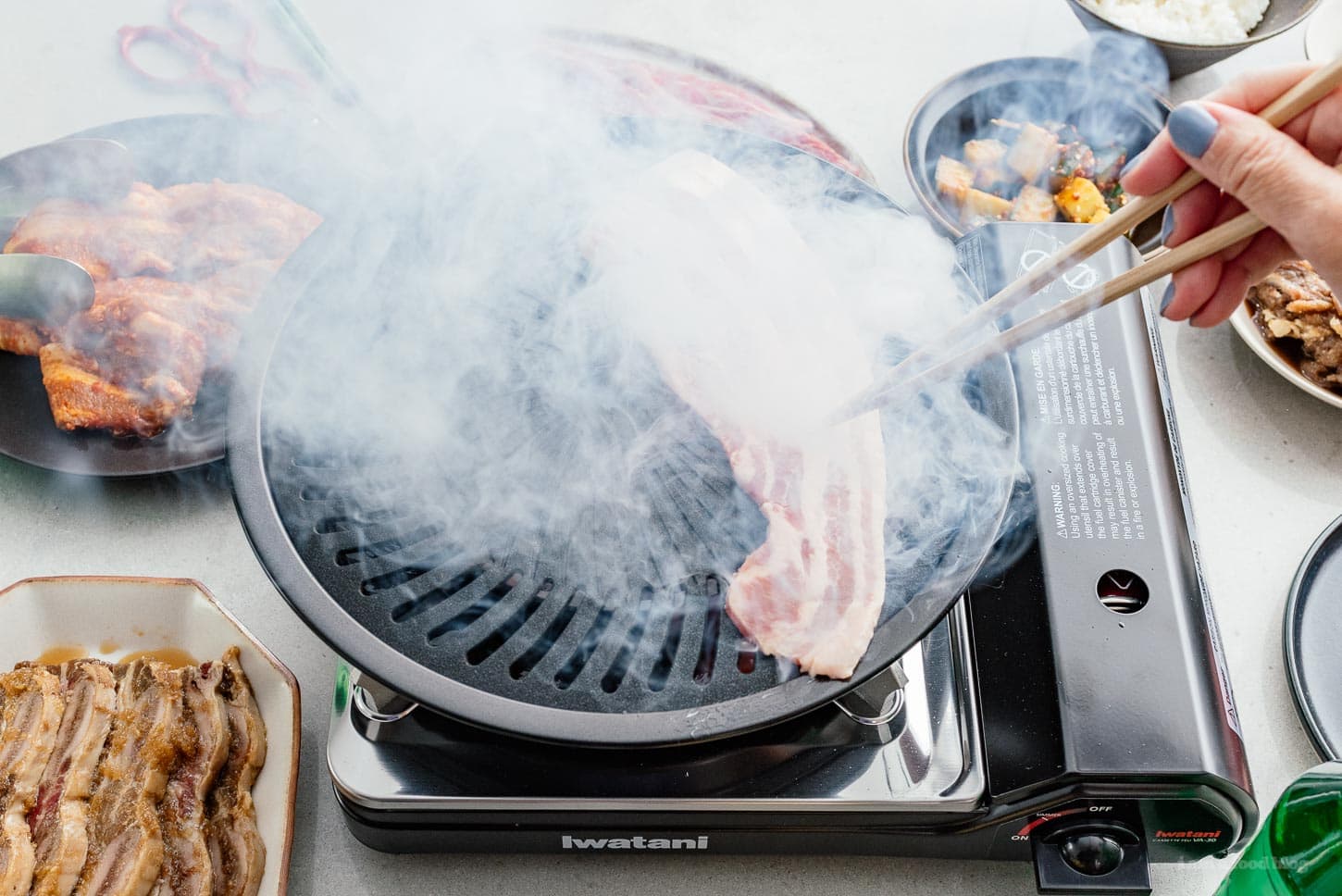

Aside from the grill/hot plate, you’ll need a bunch of tiny dishes for your banchan, small individual dipping dishes for sauces, tongs, scissors (for cutting the meat into smaller pieces) and plates and bowls for eating. And the food, of course!
Where to buy the best korean bbq meats?
If you have access to H-Mart, a nation-wide Korean grocery store, it’s going to be the absolute best place to buy the best KBBQ meats. They will have all the right cuts and they even sell the meats marinated, if you want a super easy chill vibes BBQ night:


After H-Mart, most Asian grocery stores will have a selection of pre-sliced meats in the frozen section that are probably meant for hot pot but will work great for KBBQ.
And, finally, you can hit up the regular grocery store or a butcher. You can buy a rib-eye, pop it in the freezer and thinly slice it. Instead of Korean flanken-cut short ribs, get some boneless short ribs and slice those thin as well. Most grocery stores carry pork belly slices (sometimes called side pork) and chicken is always a good choice too, especially when you marinate it in the spicy bulgogi marinade.
The best cuts of meat for KBBQ
Beef
- Kalbi/Short Ribs: These ribs are cut specifically for KBBQ, which are flanken cut short ribs, where the ribs are cut thin across the bone. You can also do boneless short ribs too, which are usually cut a bit thicker.
- Bulgogi: Bulgogi actually refers to the sweet and savory marinade/sauce, not the cut of meat, but most commonly used are thinly cut slices of sirloin, ribeye, or brisket.
Bulgogi vs Kalbi
Even though they’re both beef, they’re not the same. The biggest difference is the cut of meat used. Bulgogi is made with thinly sliced meat and kalbi are short ribs. The marinade is essentially the same.
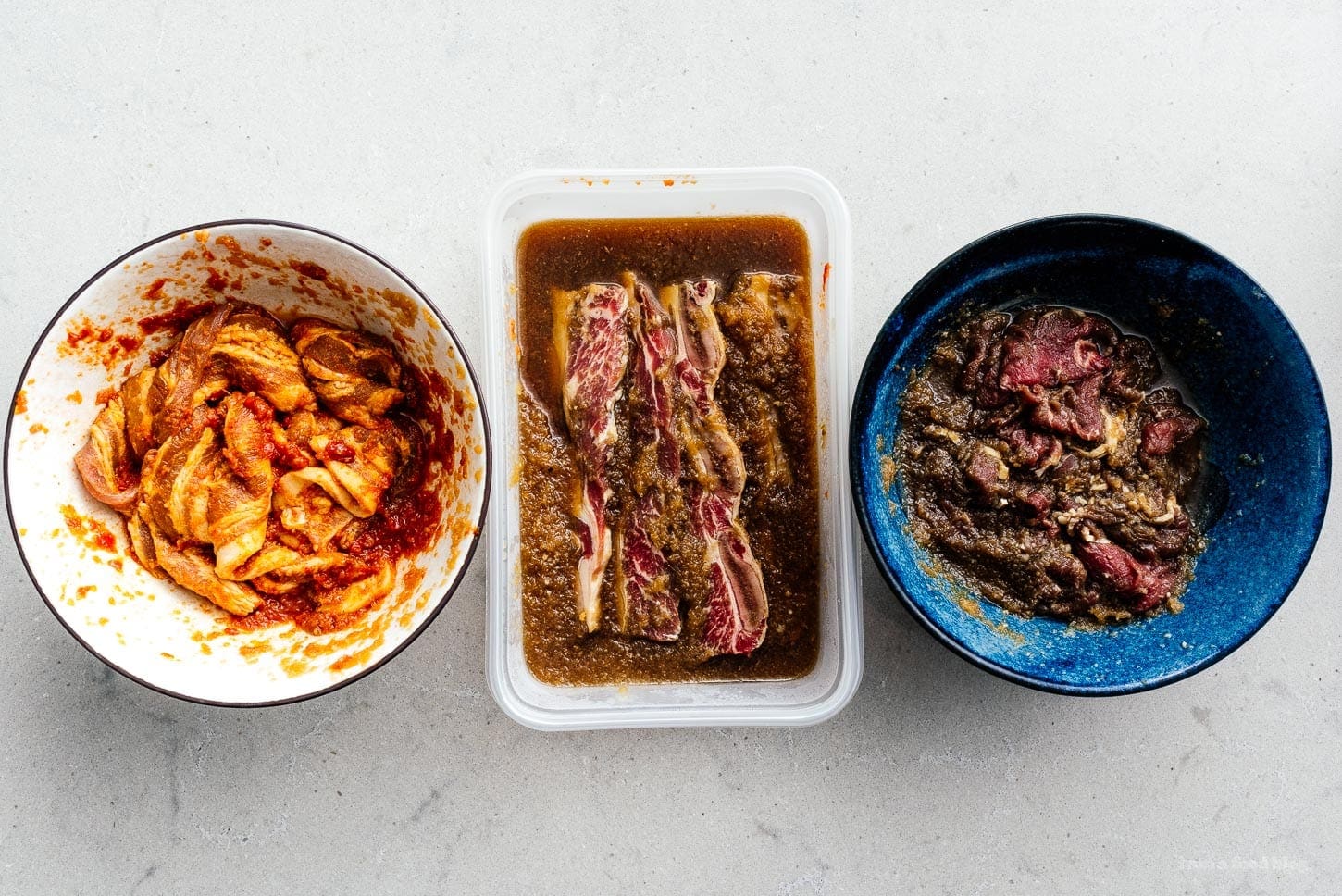

Pork
- Samgyeopsal/Pork Belly: Samgyeopsal is probably the most popular pork item because pork belly. It comes either marinated or plain and can be thick cut or thin.
- Hanjungsal/Pork Jowl: This might be my favorite cut of pork ever. Pork jowl is chewy, juicy, and perfectly marbled. It doesn’t flare up on the grill up as much as pork belly because the fat is more marbled throughout the meat. If you see it at the store, buy some, you won’t regret it! I recommend keeping hanjungsal unmarinated/plain.
Chicken
- Cheese Buldak: Chicken is not as popular at KBBQ, but they do have it, usually prepared cheese buldak style: chicken thighs marinated in a spicy gochujang fiery sauce. The thighs are grilled then, smothered in melty mozzarella cheese. I love this dish! It’s usually brought to the table in it’s own little skillet, already cooked.
- Chicken Bulgogi: If you do want to grill chicken at the table, it’s usually thighs marinated in bulgogi sauce.
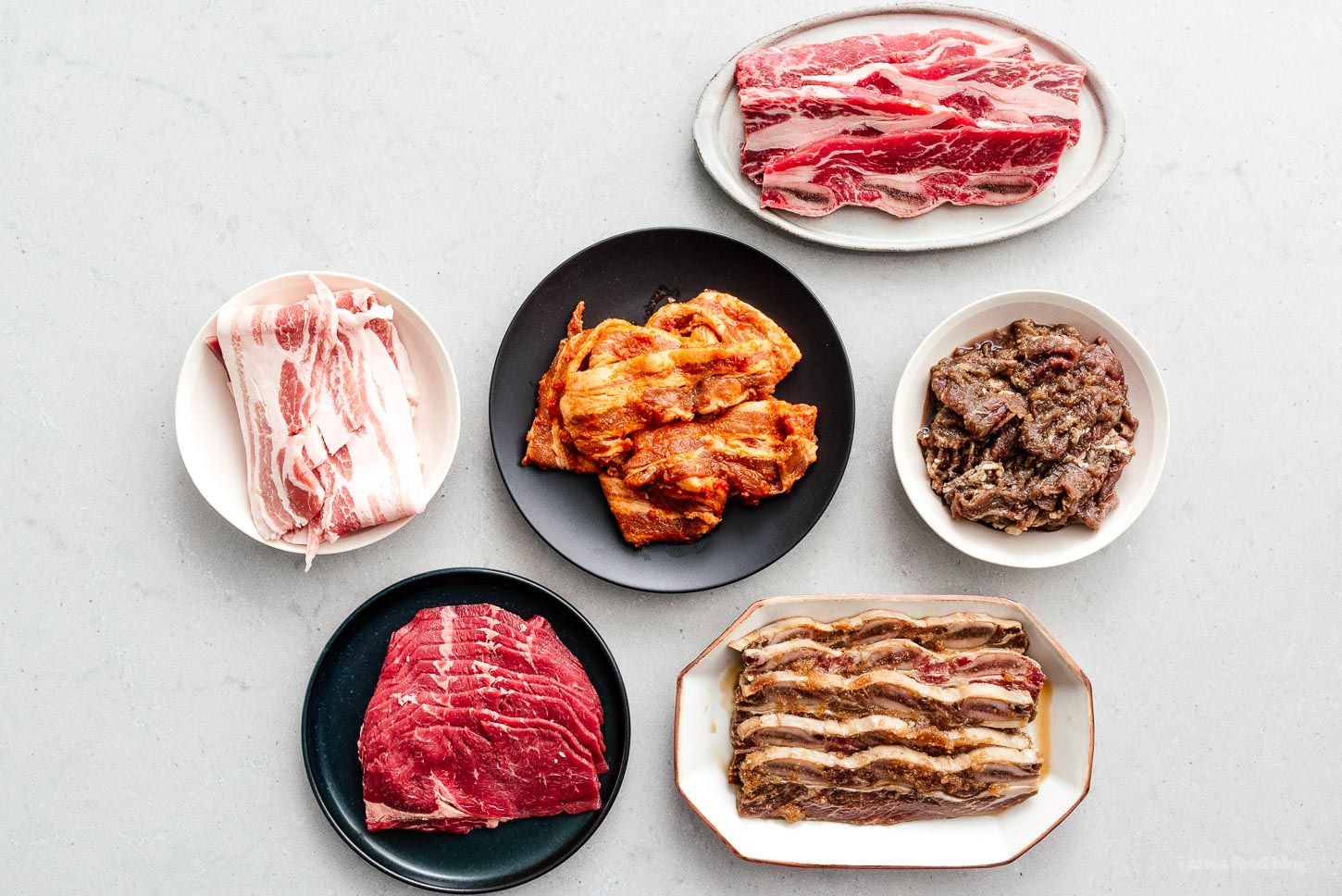

Banchan for Korean Barbecue
If you’ve ever been to a Korean restaurant you know Banchan. They are absolutely a key part of Korean barbecue. Banchan, or side dishes, are placed around the grill for everyone to share. I always judge Korean barbecue restaurants for their banchan because you know if they’re taking care with their banchan, they’re taking care with everything else.
You can make your own banchan (please check out Maangchi for some great recipes!), but if you’re lucky enough to have an H-Mart in your town or close by, it’s worth it to go there because they have a whole HUGE refrigerated section of prepared banchan. Plus you can get some Melona ice cream bars and roasted seaweed snacks that are 10 times cheaper than the seaweed snacks at Whole Foods.
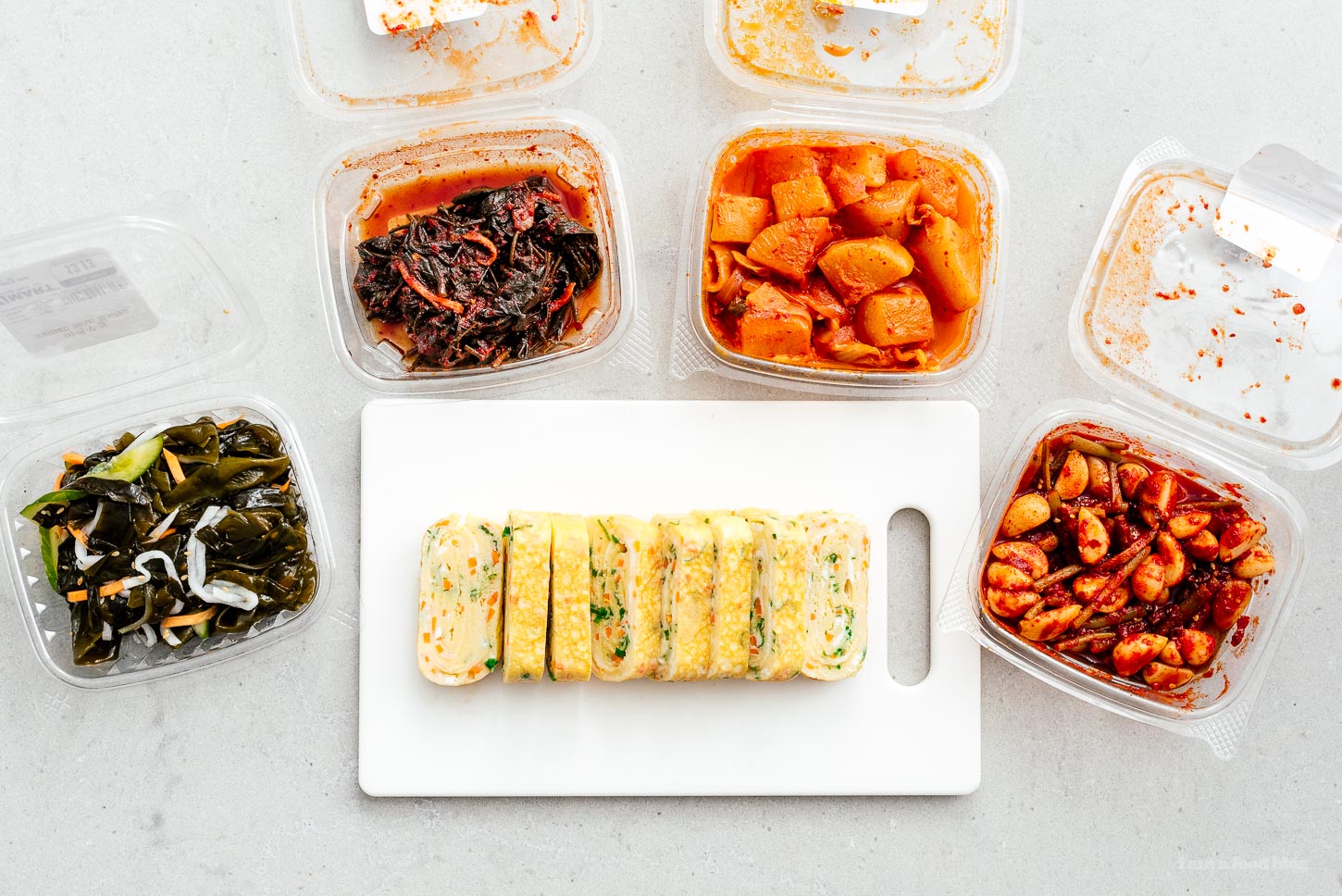

Some common banchan are:
- Kimchi: This comes in several varieties and most Korean bbq places will give you more than one kind. Buy a couple of different kimchi varieties at a local Korean grocery store. Otherwise, most large supermarkets have the standard baechu kimchi (napa cabbage). Kkakdugi, or cubed radish/daikon is super popular and oi sobagi, or cucumber is always a good choice.
- Kongnamul: These are soy bean sprouts that are seasoned with sesame oil, soy, scallions and garlic.
- Danmuji: These iconic picked yellow daikon are the kind that you find in kimbap! Crunchy, sweet and sour, and so addictive.
- Gim/Seaweed: There are a bunch of different seaweed banchan you can get: seasoned seaweed salads made with roasted seaweed (doljaban muchim), seaweed stems (miyeok julgi bokkeum), wakame (miyeok muchim).
- Gamja/Potatoes: This is my FAVORITE banchan umbrella – all the potato side dishes. There’s potato salad (gamja saelleodeu), sweet and savory braised potatoes (gamja jorim), and sticky soy glazed potatoes (gamja bokkeum). Give me ALL the gamja!
- Eggs: Gyeran jangjorim, or soy marinated eggs (either regular or quail) make for a cute and tasty side dish. Rolled omelette (gyeran mari) is what I consider a premium banchan because who doesn’t love a rolled omelette studded with vegetable confetti?! I also love gyeranjjim, which are steamed eggs that come in a little stoneware pot.
- Jeon/Pancakes: Again, this is a premium banchan! If you want to go ALL out, break out the jeon, which are savory pancakes/battered pan-fried deliciousness. The classic is pajeon (green onion pancake) or kimchijeon (kimchi pancake), but there are haemuljeon (seafood), and even gamjajeon (potato ?)
My favorite banchan to make at home: gyeran mari
Rolled omelette/gyeran mari is the best banchan because they’re pretty and taste amazing too! How could you not love rolled eggs with tiny vegetable confetti?! Here’s how you make it:
- Finely chop some scallions and carrots, you want about 1 and a half tablespoons of each.
- Lightly whisk together 4 eggs and season with salt, making sure they’re evenly mixed.
- Stir in the finely chopped vegetables.
- Use a small nonstick frying pan and heat up a bit of oil over medium low heat.
- Add about 1/3 of the egg mix and swirl to coat the pan.
- Cook until the egg just starts to set then use a spatula to fold the egg over about 2 inches. Continue to fold and roll it, then push it to one side of the pan.
- In the empty spot in the pan, add some more of the egg mix, letting it cook until it is just about set but still runny on top. Roll the egg up and push it to one side of the pan.
- Repeat until you finish the egg mix.
- Remove from the pan, let cool slightly, and slice into thick slices.
- Enjoy along with your KBBQ!
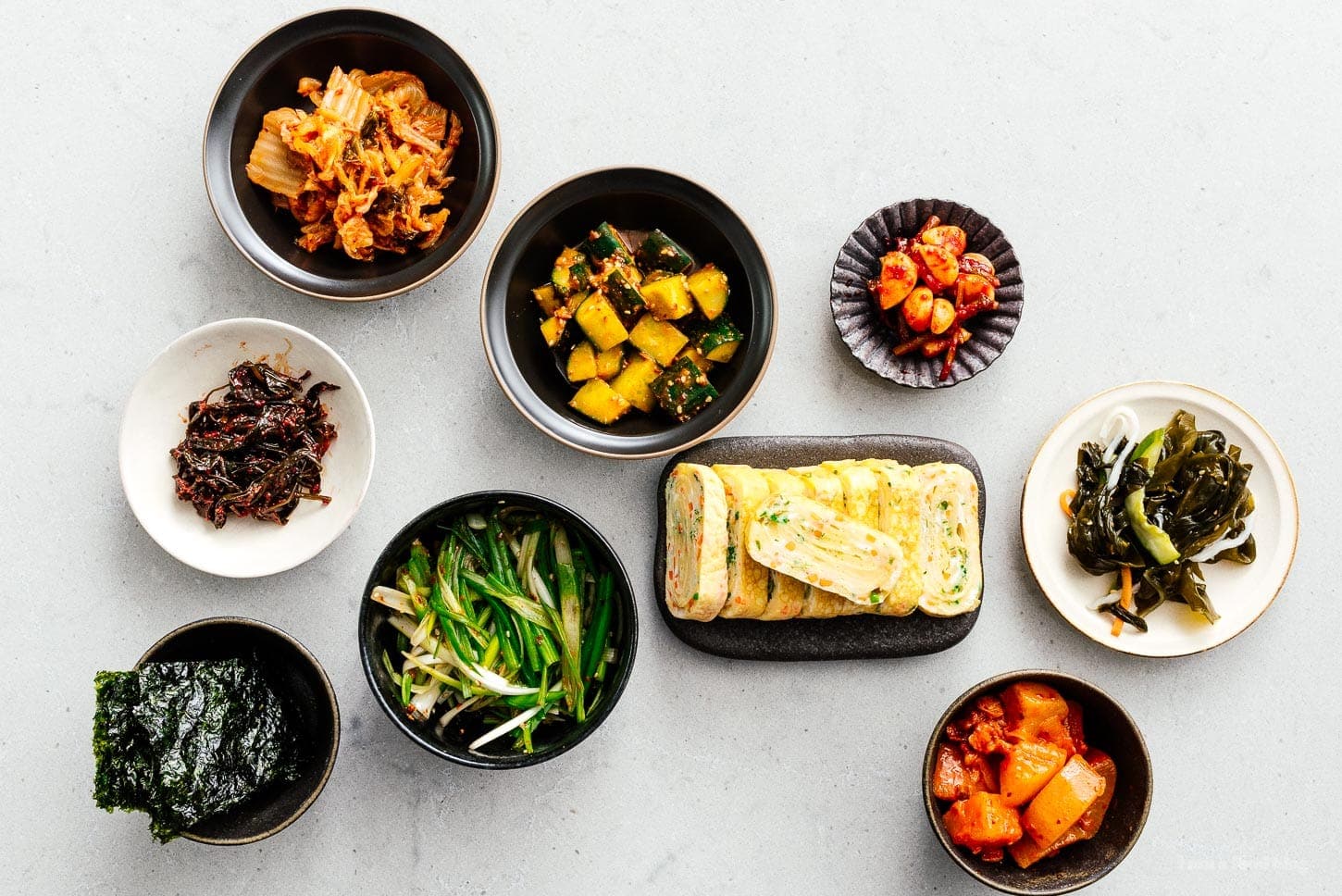

Korean BBQ Sauces
It isn’t a KBBQ party without sauces! The table needs sauces and seasoning so everyone can customize to their hearts content.
- Ssamjang: This translates to wrap sauce and that’s exactly what it is, sauce to put on your ssam/wrap. It’s made up of soybean paste/doenjang, hot pepper paste/gochujang, sugar, green onions, garlic, toasted sesame oil, and toasted sesame seeds. Every one has their own recipe so don’t be afraid to riff and adjust to what you like. Ssamjang is savory and sweet and touch spicy and really, really good.
- Toasted sesame oil: A little dipping bowl of toasted sesame oil is a pro-move. Use this, with a bit of salt sprinkled on top when you want to really taste the pure flavors of the meat. I love it with pork, especially pork that hasn’t been marinated.
- Salt: Just a little dish of salt for sprinkling onto the un-marinated meats to bring out their meaty flavors. Flakey sea salt is extra luxe.
- Toasted sesame seeds: A sprinkle of toasted sesame seeds can add an extra hit of savory nuttiness to your ssam.
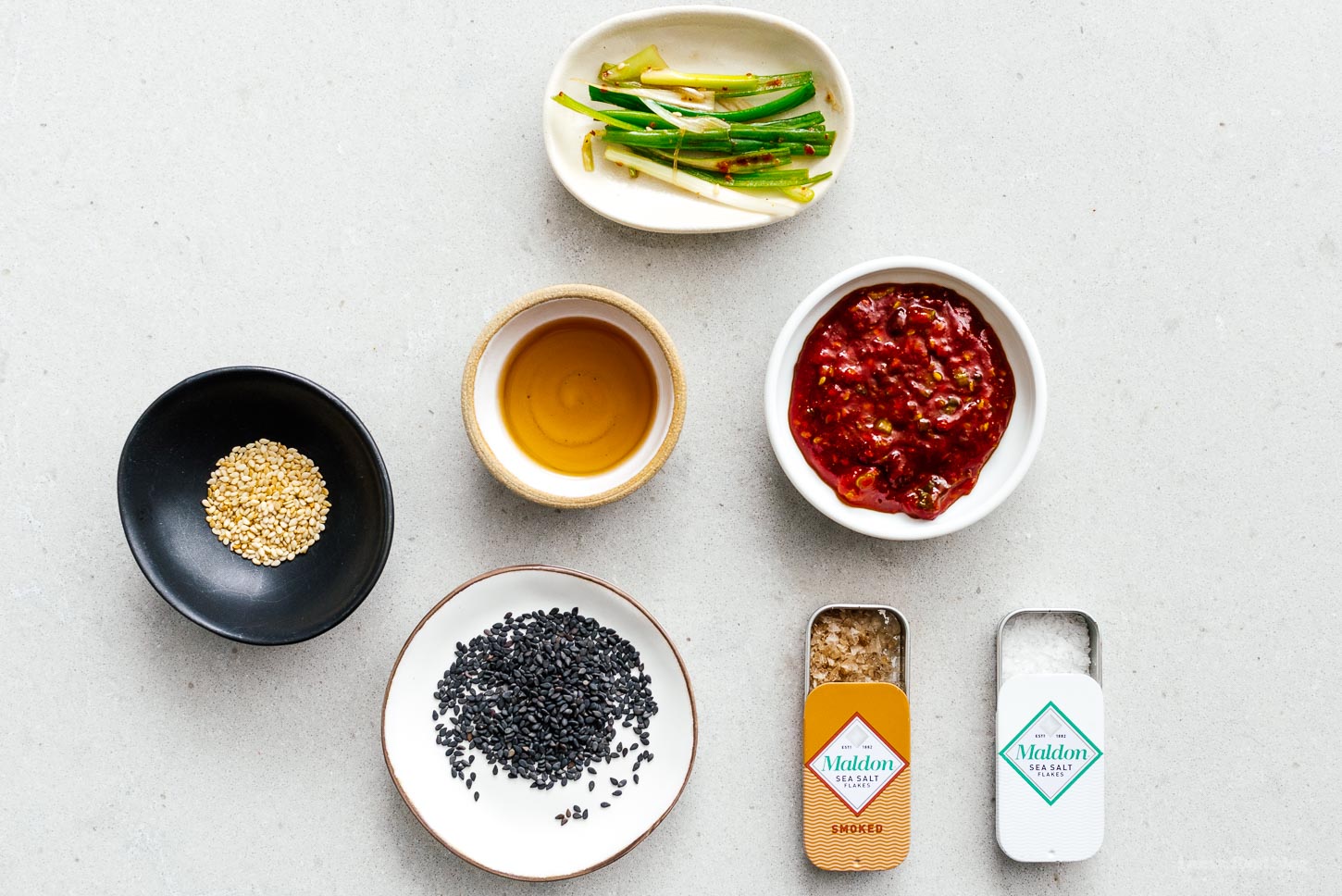

Here are three KBBQ dipping sauce recipes to get you started
Sesame oil, salt, and pepper
A super savory sauce that lets the flavors of the ingredient that you’re grilling shine through. 2 tsp toasted sesame oil plus 1 small pinch salt and freshly ground black pepper.
Ssamjang
This is a thick sauce that works best when you scoop it in your ssam! 1 teaspoon each doenjang, gochujang, toasted sesame oil, honey, toasted sesame seeds and 1 clove garlic, minced.
Sweet and spicy gochujang
This is a basic sweet and spicy sauce that goes well with everything. 1 tablespoon each of gochujang, sugar or honey, and rice vinegar, plus a squeeze of fresh lemon and thinly sliced green onions or toasted sesame seeds.
Vegetables
- Lettuce: You’ll need lots of lettuce and perilla to wrap up your grilled meats in little bites. I like providing a bunch of different lettuces. Lettuces for for Korean barbecue to try: red leaf, green leaf, butter, romaine, iceberg, really, any lettuce you enjoy can be used as a wrap.
- Perilla: Pick up some perilla when you’re at the Korean market. It’s a flat wide leaf that is sometimes labeled as sesame leaves. Perilla are in the mint family but they don’t quite taste like mint, more like Japanese shiso (if you’ve had that) or a fresh herby flavor with a hint of anise.
- Chili: It wouldn’t be Korean food without a bit of spice. Most Korean restaurants will have sliced Korean green chilis, but you can sub sliced jalapeños or serranos.
- Green onions: A huge pile of slivered or shredded green onions adds freshness and flavor. Usually the green onions are tossed in a bit of soy, toasted sesame oil, sugar, and sesame seeds for a quick green onion slaw that tastes amazing with pork.
- Crunchy vegetables: You can also add some vegetable sticks or slices like cucumbers and carrots.
- Garlic: Raw garlic slices for those garlic lovers out there – just pop a slice on top of the meat in your ssam
Rice or noodles
You’ll probably be full after all the meat, but most KBBQ places offer rice and noodles at the end, just as an ending to the meal. Mike actually loves putting rice into his ssam, so if you like, serve up some bowls of rice with your KBBQ. As for noodles, well, who doesn’t love noodles? Super popular is naengmyeon, or cold noodles, because after all the heat, you’ll want to cool down with a bowl of slippery, savory icy cold noodles.
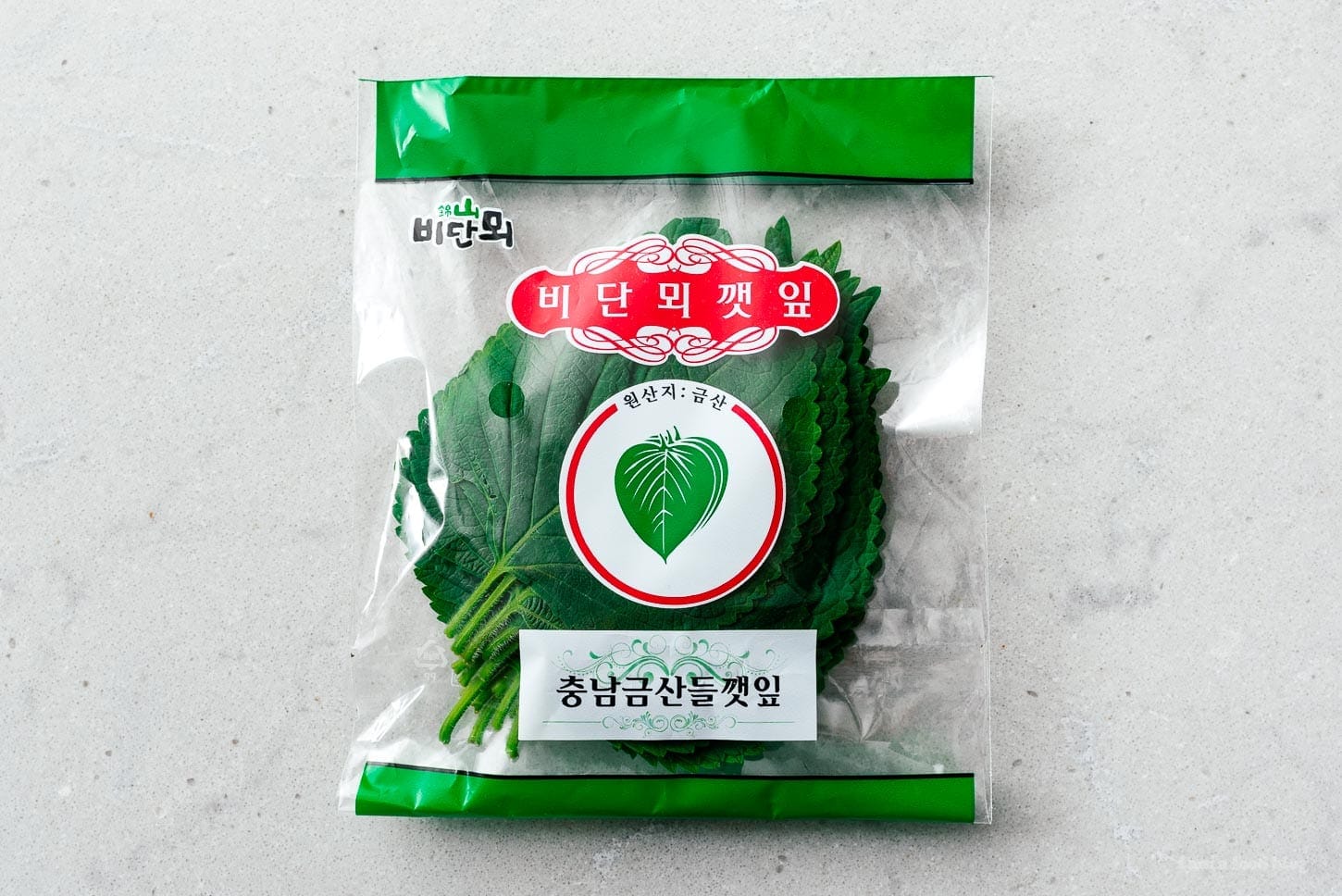

How much food/meat do you need?
- Meat
Plan on 1/2 to 3/4 pound of meat per person. If you have big meat eaters, plan on 1 pound of meat per person. If you’re having bone-in short ribs, double the amount of short ribs, because of bones. - Vegetables
Get at least 1 head of lettuce and 1 pack/bunch of perilla leaves between two people. - Banchan
Plan on 1-2 ounces of each kind of banchan and aim for 4 (or many more) varieties. - Rice
Make 1/2 cup of uncooked rice per person, which will give you about 1.5 cups cooked.
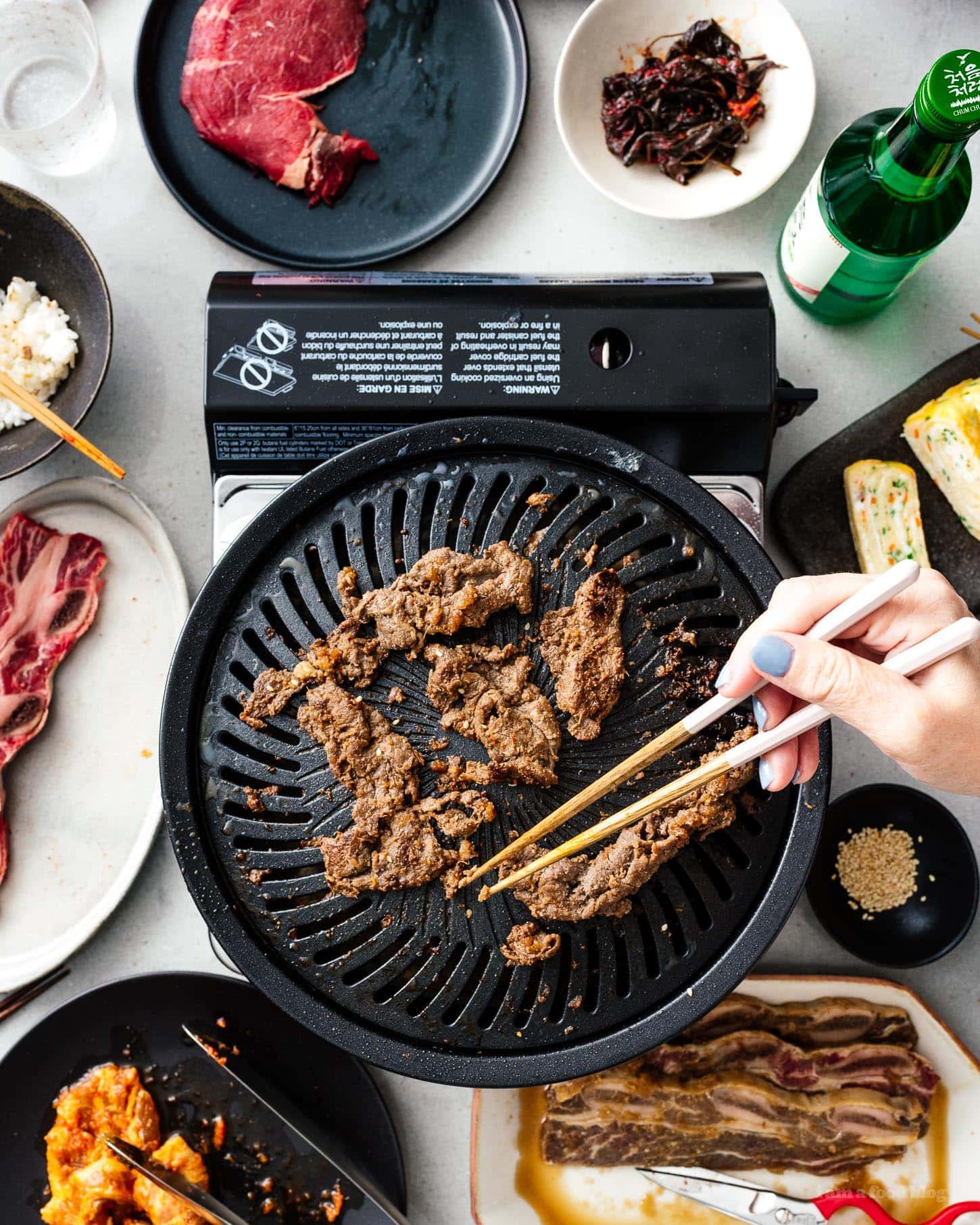

Do you need the marinade?
You don’t have to! Lots of times Korean BBQ actually comes naked so you can appreciate the pure flavors of the meats. This is actually how Japanese people like to do Korean BBQ at yakiniku. We kept some of the meats plain so we could enjoy them with salt and sauce.
What about smoke?
Not going to lie, if you’re grilling meat, there is going to be smoke, especially if your meat is marinated. KBBQ restaurants have very powerful hood fans that suck up the smoke so you don’t notice it when you’re eating there. To keep smoke at a healthy level at home, make sure your windows are open and your hood fan is on.
Better yet, now that it is summer, have your KBBQ feast outside! Heck, even in the winter it’s fun to grill outside, underneath blankets. In Seoul, they have outdoor places where there are heaters and blankets for a cozy experience.
To minimize smoke, always cook unmarinated meats first, then move on to marinated meats. If it starts to get extremely smoky, take a break and change or clean the grill plate. If your smoke detector goes off, there’s often a button you can use to tell it that everything is fine. It’s all part of the experience!
How to set the table
Aside from the grill and the ingredients, there are a couple of things that will make your KBBQ night go smoothly.
Table
- This is pretty obvious, but it goes without saying that KBBQ takes up a lot of room so a big table is optimal. If you have a smaller table, keep some of the meats and banchan near by on the countertop and replenish as needed. The table will get oily due to some splatter so you might way to lay down something to protect the surface.
Utensils
- Tongs – These are for both grabbing meats to put on the grill and using them to grill the meats on the grill. Usually you’ll only get one or two sets of tongs at the restaurant and someone will take care of the grilling while everyone else relaxes and eats. Two pairs ensures that you use one for raw meat and one for meat that is cooked.
- Chopsticks – Metal chopsticks are traditionally Korean but a lot of people have a hard time using them because they’re flat instead of round or squared off. I recommend wooden chopsticks!
- Scissors – These are for cutting pieces of meat into smaller pieces either for them to cook faster or to cut cooked pieces of meat into more manageable pieces. Use them copiously!
Dishes
- Small bowls – small round bowls are perfect for rice and banchan and don’t take up too much premium table space.
- Small plates – mini plates mean you can fit more banchan on the table.
- Dipping bowls – you’ll need dipping bowls for the sauces, sesame oil, sesame seeds, and salt.
What to drink with KBBQ
Most people like drinking beer and soju. Of course makgeolli, a sweet milky rice wine, is super popular too. You can also do mixed drinks like Yakut and soju, Melona and soju, or soda and soju. If you’re going non-alcoholic, iced teas are perfect.
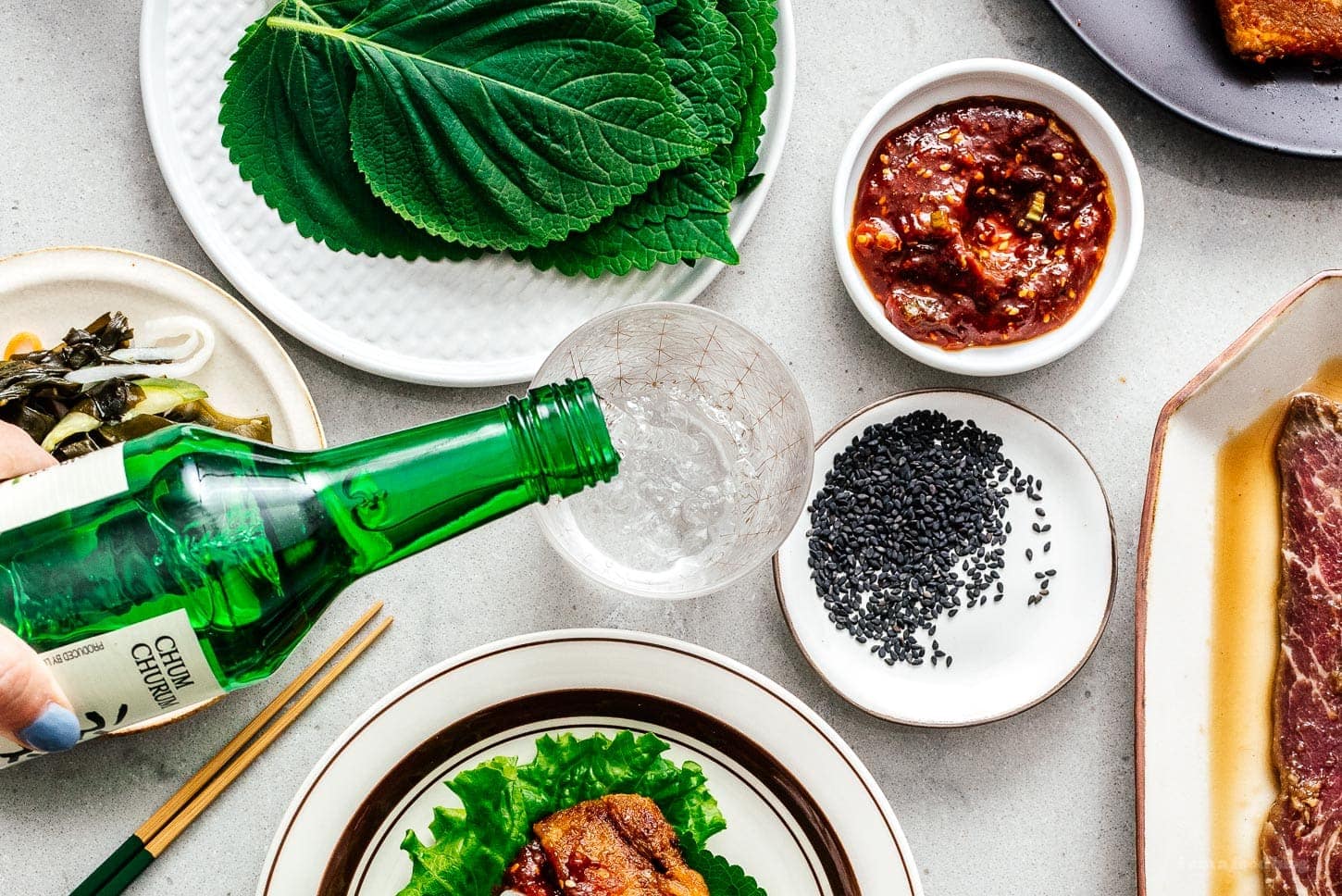

I hope this post has inspired you to do Korean barbecue at home. Really, it’s a ton of fun and SO delicious.
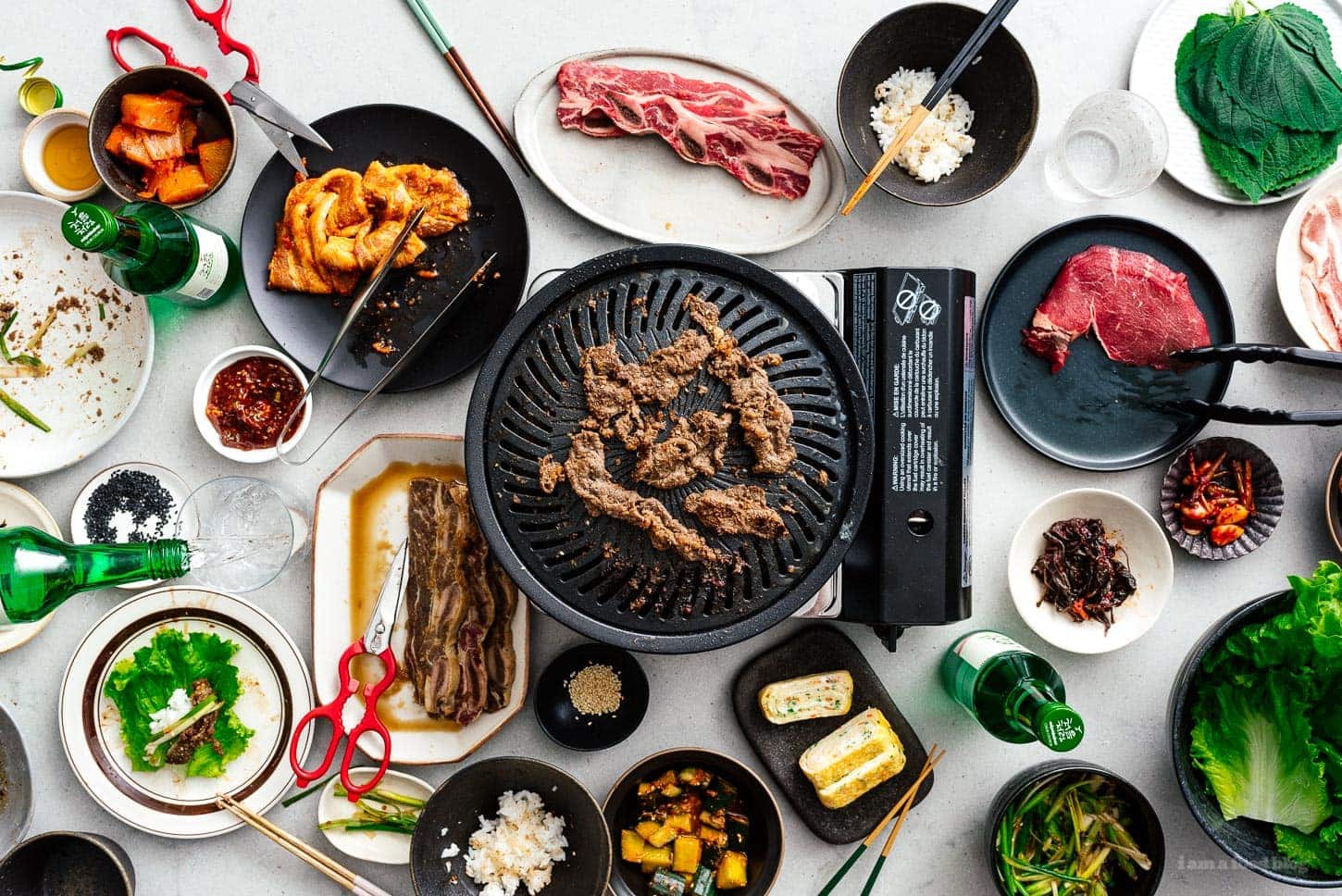

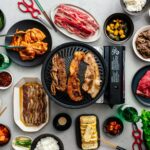

Korean BBQ at Home
A complete guide to Korean BBQ at home featuring Kalbi short ribs, bulgogi brisket and spicy bulgogi pork belly, as well as all the fixings needed for a night of celebration, fun, and meat.
Serves 4
Kalbi/Bulgogi Marinade
- 1 medium onion chopped, roughly 2 cups
- 1 pear cored, Asian pear preferred, roughly 1 cup
- 8 cloves garlic minced
- 1 tbsp ginger crushed
- 1/2 cup soy sauce low sodium preferred
- 1/4 cup brown sugar
- 2 tbsp toasted sesame oil
- 2 tbsp rice vinegar
- 1 tsp black pepper
- 1 tbsp gochujang Korean hot pepper paste
Meats
- 2 lb bone-in short ribs Korean cut (thinly sliced), use 1/2 the amount if boneless
- 1 lb brisket thinly sliced, sirloin or ribeye ok as well
- 1 lb pork belly thinly sliced
Ssamjang (dipping sauce)
- 1 cup doenjang Korean fermented soy bean paste
- 1/2 cup gochujang Korean hot pepper paste
- 1/4 cup honey
- 1/4 cup toasted sesame oil
- 8 green onions thinly sliced
- 8 cloves garlic crushed
- 2 tbsp toasted sesame seeds
Pajeori (Green Onion Slaw)
- 6 green onions
- 1 tbsp soy sauce
- 2 tsp toasted sesame oil
- 1/2 tsp sugar
- 1/2 tsp toasted sesame seeds
- 1 tsp gochugaru Korean hot pepper flakes, optional
Assembly
- 4-8 oz Banchan at least 4 kinds, see post
- 2 heads lettuce mix/match of red leaf, green leaf, butter, romaine, iceberg
- 2 packs perilla leaves
- 1 cup crunchy vegetables julienned
- 6-8 cloves garlic raw, sliced
- 2-3 jalapeños sliced
- 6 cups cooked rice
- 16 oz naengmyeon Korean cold noodles, prepared, optional
- 4 tbsp toasted sesame oil
- 4 tbsp toasted sesame seeds
- 4 tsp flaky sea salt
-
Well before you want to eat, make the marinade: In a blender, blend the onion, pear, garlic, and ginger with 1/4 cup water, then combine the onion-pear mix with the soy sauce, brown sugar, toasted sesame oil, and black pepper. Marinate your meats for a minimum of 2 hours or overnight: Kalbi short ribs: use 1/3 of the marinade with the Korean cut short ribsBulgogi brisket: use 1/3 of the marinade with your thinly sliced brisket (or sirloin or ribeye)Spicy Bulgogi pork belly: finally, add 1 tbsp gochujang (or more, if you want it spicier) to the remaining marinade and combine with the pork belly.
-
Combine the ssamjang ingredients to make the ssamjang. Set aside, covered, in the refrigerator so the flavors can meld.
-
Make the green onion slaw: Trim the green onions then cut into 3 inch lengths. Slice each piece longways so you get shredded green onions. Soak in cold water for 5 minutes, drain well, then toss the remaining ingredients. Refrigerate, covered, until ready to use.
-
When you are ready to eat, lay out the banchan on small plates, cook your rice, and divide your ssamjang and other seasonings up among the table.
-
Cook the meat on the hot plate/grill pan, flipping as needed. Enjoy as ssam!
You aren’t restricted to these meats, feel free to buy whatever strikes your fancy or is easy/comfortable! For chicken, try chicken thighs, cut into 1 inch pieces. For pork, try pork jowl if you can find it!
This is probably actually enough food for 6 but it’s better to have leftovers vs. running out of food at a Korean BBQ.
Estimated nutrition doesn’t include side dishes, sauces…or alcohol.
Nutrition Facts
Korean BBQ at Home
Amount Per Serving
Calories 1169
Calories from Fat 717
% Daily Value*
Fat 79.7g123%
Saturated Fat 29.9g187%
Cholesterol 186mg62%
Sodium 1473mg64%
Potassium 663mg19%
Carbohydrates 25.3g8%
Fiber 2.7g11%
Sugar 16.3g18%
Protein 53.5g107%
* Percent Daily Values are based on a 2000 calorie diet.














Post Comment